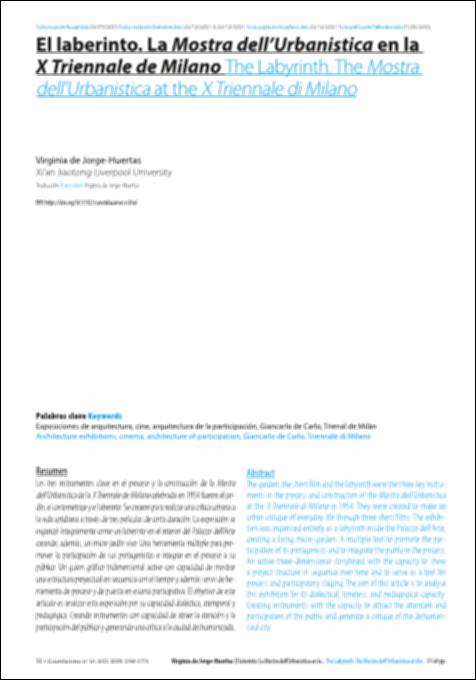Please use this identifier to cite or link to this item:
http://hdl.handle.net/10637/13807El laberinto : La Mostra dell'Urbanistica en la X Triennale de Milano.
| Title: | El laberinto : La Mostra dell'Urbanistica en la X Triennale de Milano. The Labyrinth: The Mostra dell'Urbanistica at the X Triennale di Milano |
| Authors : | Jorge-Huertas, Virginia de |
| Keywords: | Exposiciones de arquitectura.; Cine.; Arquitectura de la participación.; Giancarlo de Carlo.; Trienal de Milán.; Architecture exhibitions.; Cinema.; Architecture of participation.; Triennale di Milano. |
| Abstract: | Los tres instrumentos clave en el proceso y la construcción de la Mostra
dell’Urbanistica de la X Triennale de Miilano celebrada en 1954 fueron el jardín, el cortometraje y el laberinto. Se crearon para realizar una crítica urbana a
la vida cotidiana a través de tres películas de corta duración. La exposición se
organizó íntegramente como un laberinto en el interior del Palazzo dell’Arte
creando, además, un micro jardín vivo. Una herramienta múltiple para promover la participación de sus protagonistas e integrar en el proceso a su
público. Un guion gráfico tridimensional activo con capacidad de mostrar
una estructura proyectual en secuencia con el tiempo y además servir de herramienta de proceso y de puesta en escena participativa. El objetivo de este
artículo es analizar esta exposición por su capacidad dialéctica, atemporal y
pedagógica. Creando instrumentos con capacidad de atraer la atención y la
participación del público y generando una crítica a la ciudad deshumanizada. The garden, the short film and the labyrinth were the three key instruments in the process and construction of the Mostra dell'Urbanistica at the X Triennale di Milano in 1954. They were created to make an urban critique of everyday life through three short films. The exhibition was organised entirely as a labyrinth inside the Palazzo dell'Arte, creating a living micro-garden. A multiple tool to promote the participation of its protagonists and to integrate the public in the process. An active three-dimensional storyboard with the capacity to show a project structure in sequence over time and to serve as a tool for process and participatory staging. The aim of this article is to analyse this exhibition for its dialectical, timeless, and pedagogical capacity. Creating instruments with the capacity to attract the attention and participation of the public and generate a critique of the dehumanised city. |
| Description: | En: Constelaciones. ISSN. 2340-177X. n. 10, 2022, pp 51-68 |
| URI: | http://hdl.handle.net/10637/13807 |
| Rights : | http://creativecommons.org/licenses/by-nc-nd/4.0/deed.es |
| Issue Date: | 24-Jun-2022 |
| Appears in Collections: | Núm. 010 (2022) |
Items in DSpace are protected by copyright, with all rights reserved, unless otherwise indicated.


